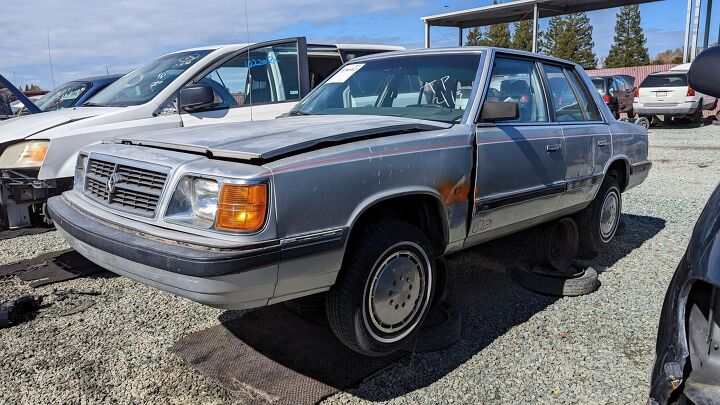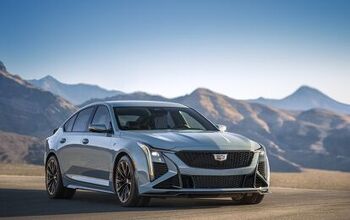Junkyard Find: 1986 Dodge Aries SE Four-Door Sedan

Lee Iacocca's Chrysler Corporation sold K-Cars in the United States for the 1981 through 1989 model years, saving itself from near-certain bankruptcy in the process. These cars are becoming difficult to find in the Ewe Pullets of the land, and I hadn't written about a true K in the Junkyard Finds series since way back in 2019. Today, we'll look at a K sedan that survived 36 years before being retired in California.
After a decade of fuel shortages and general malaise, Detroit (and Kenosha) knew that American car buyers still loved soft-riding, roomy sedans with comfy bench seats but needed them to be more efficient. For the 1980s, GM created the X-Cars, Ford offered Fox sedans and American Motors had the Concord. Chrysler did perhaps the best job of recreating the occupant experience of, say, a Plymouth Satellite sedan in a vehicle that got twice the fuel economy.
Look at that interior! Cloth-and-vinyl seats that felt like Grandpa's La-Z-Boy, the automatic shift lever on the column where God intended, and an utter lack of pretentious European coldness or punitively sensible Japanese practicality. It was (sometimes) hard to believe that this was a four-cylinder compact with front-wheel-drive.
Though the extended Chrysler K Family had many members (including minivans and Maseratis) and stayed in production deep into the 1990s, there were just five true K models sold in the United States: the Plymouth Reliant, Dodge Aries, Dodge 400, Dodge 600 and Chrysler LeBaron (though not all the LeBarons and 600s were genuine Ks).
The Aries and Reliant sedans were the real sales heroes of the K family during the 1980s. Like the Dodge/Plymouth Colt or Omnirizon of the same era, the two generally had identical sticker prices and were distinguishable from each other only if you looked closely at grilles and emblems.
1986 was the first model year in which every Aries and Reliant got electronic fuel injection. The 2.6-liter Mitsubishi Astron aka "Hemi 2.6" engine (optional in the Aries and Reliant through 1985) was gone, replaced by a 2.5-liter Chrysler. This car has the base 2.2, rated at 97 horsepower and 122 pound-feet.
The 100-horse/138-pound-foot 2.5 cost an extra $279, or $782 in 2023 dollars.
The emissions sticker tells us that this car was originally sold in California, and that its first owner paid $99 extra ($277 now) for the equipment that made it meet the Golden State's smog requirements.
The SE was the top Aries trim level for 1986, and the MSRP for this car started at $7,759 (about $21,737 after inflation).
This car almost certainly cost a lot more than that. The three-speed automatic transmission listed at $504 ($1,412 in today's money), for example.
The air conditioning was $757 ($2,121 today), but at least the AM/FM stereo radio was standard equipment in the Aries LE and SE.
We can assume it would still be on the road today, had it not been hit in the right rear. It doesn't take much to total a car with a triple-digit resale value.
My personal K-Car experience hasn't been as positive. A decade ago, I endured enjoyed the misfortune character-building experience of a Denver-to-San Francisco journey with the K-It-FWD 1987 Plymouth Reliant 24 Hours of Lemons race car (feel free to send nastygrams to Car and Driver about whatever terrible glitch jankified the formatting in those articles, by the way).
Hey, that cash back just about covers the A/C and automatic!
The dance moves of the Dodge Boys in this commercial seem more appropriate for the 600 coupe, or maybe even the Lancer Turbo.
Naturally, you can't discuss the Aries without sharing one of the earliest viral videos of the Internet Era. I recall angrily futzing with video codecs in order to watch the file I'd laboriously downloaded of this spoof Aries commercial, circa 2000.
1986 Dodge Aries in California wrecking yard.
1986 Dodge Aries in California wrecking yard.
1986 Dodge Aries in California wrecking yard.
1986 Dodge Aries in California wrecking yard.
1986 Dodge Aries in California wrecking yard.
1986 Dodge Aries in California wrecking yard.
1986 Dodge Aries in California wrecking yard.
1986 Dodge Aries in California wrecking yard.
1986 Dodge Aries in California wrecking yard.
1986 Dodge Aries in California wrecking yard.
1986 Dodge Aries in California wrecking yard.
[Images: The Author]
Become a TTAC insider. Get the latest news, features, TTAC takes, and everything else that gets to the truth about cars first by subscribing to our newsletter.

Murilee Martin is the pen name of Phil Greden, a writer who has lived in Minnesota, California, Georgia and (now) Colorado. He has toiled at copywriting, technical writing, junkmail writing, fiction writing and now automotive writing. He has owned many terrible vehicles and some good ones. He spends a great deal of time in self-service junkyards. These days, he writes for publications including Autoweek, Autoblog, Hagerty, The Truth About Cars and Capital One.
More by Murilee Martin
Latest Car Reviews
Read moreLatest Product Reviews
Read moreRecent Comments
- Golden2husky Glad it is on hold...it was a bad way to try to address the congestion issue.
- Daniel J I was interested until it appears that this thing won't do 0-60 under 7 seconds. I get it, many folks don't need speed deamons, but c'mon. This thing is too slow for what they are asking for it. Mazda seems to be the only mainstream brand that seems to be trying when it comes to some performance in these larger suvs.
- TheEndlessEnigma To answer the headline. No. I think a legal argument could be make that "congestion" pricing is nothing more than applying tolls to public roads with variable fees based on nothing more than Political Overlord whims and could, therefore, be considered unconstitutional as constraint of interstate trade and restricting movement of citizens.
- Carsofchaos A lot of the congestion comes from what's been done to streets like 1st Avenue, which I drive on every day: This was once a four lane northbound avenue. Then a bus lane was created, so now we're down to 3 lanes. Then a seldom-used (other than at peak hours in the summer) bike lane was created, so now we're down to 2 lanes. Then you have delivery trucks who have lost their spot due to the bus/bike lanes, who now must double park to do deliveries. Now we're down to one lane. ONE. See the problem? Vacancy rates for office buildings still is at 30% (I know this because we are moving our office to a new location in Midtown and we were constantly seeing how many buildings had a plethora of empty office space), and Wokeul's congestion pricing would have made sure that number never gets better. And let's be honest, we all know the MTA would effff this up and still be broke anyway.
- Redapple2 One of the last offerings of the Gladiator? It s being discontinued?
























































Comments
Join the conversation
When cars had one simple mission: get me where I’m going. Now they have AI powered touch screens, remotely monitored and lojacked, weight 6000 lbs, have 22 air bags, 104 CPU’s and 800HP. To do exactly the same thing.
I thought there were three levels of Aries available? America? The SE & the LE?
these were all over the roads when I started driving. However I couldn’t afford new at the time because my employer didn’t pay a living wage? I was looking for a second hand version but they were either dog eared from heavy use or were smoker’s cars. Neither of which I wasn’t willing to own? A neighbor had one & it was well worn with lots of dents & bumper stickers. Later another daughter turned it into an ashtray on wheels. It was used up by the time they sold it.